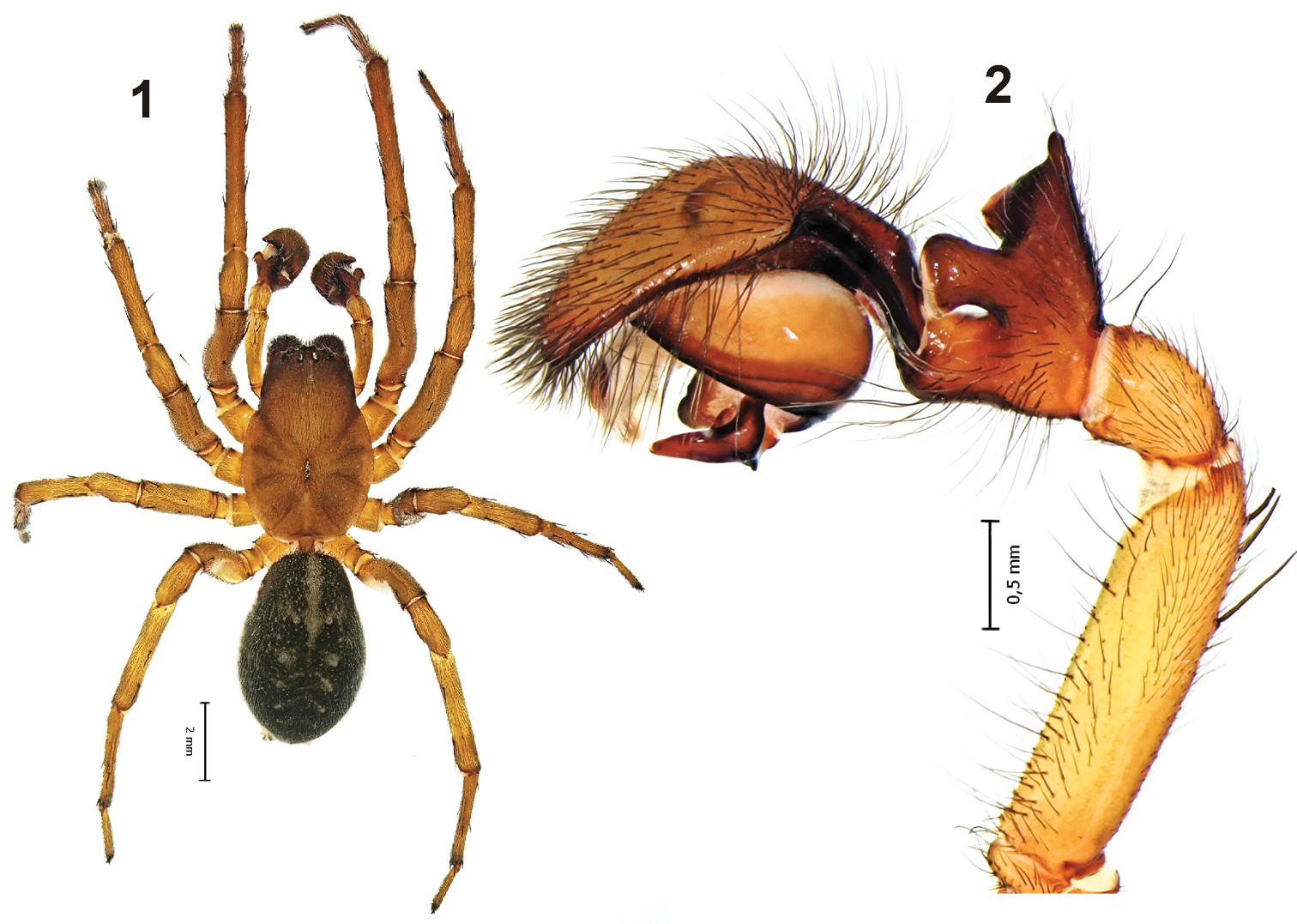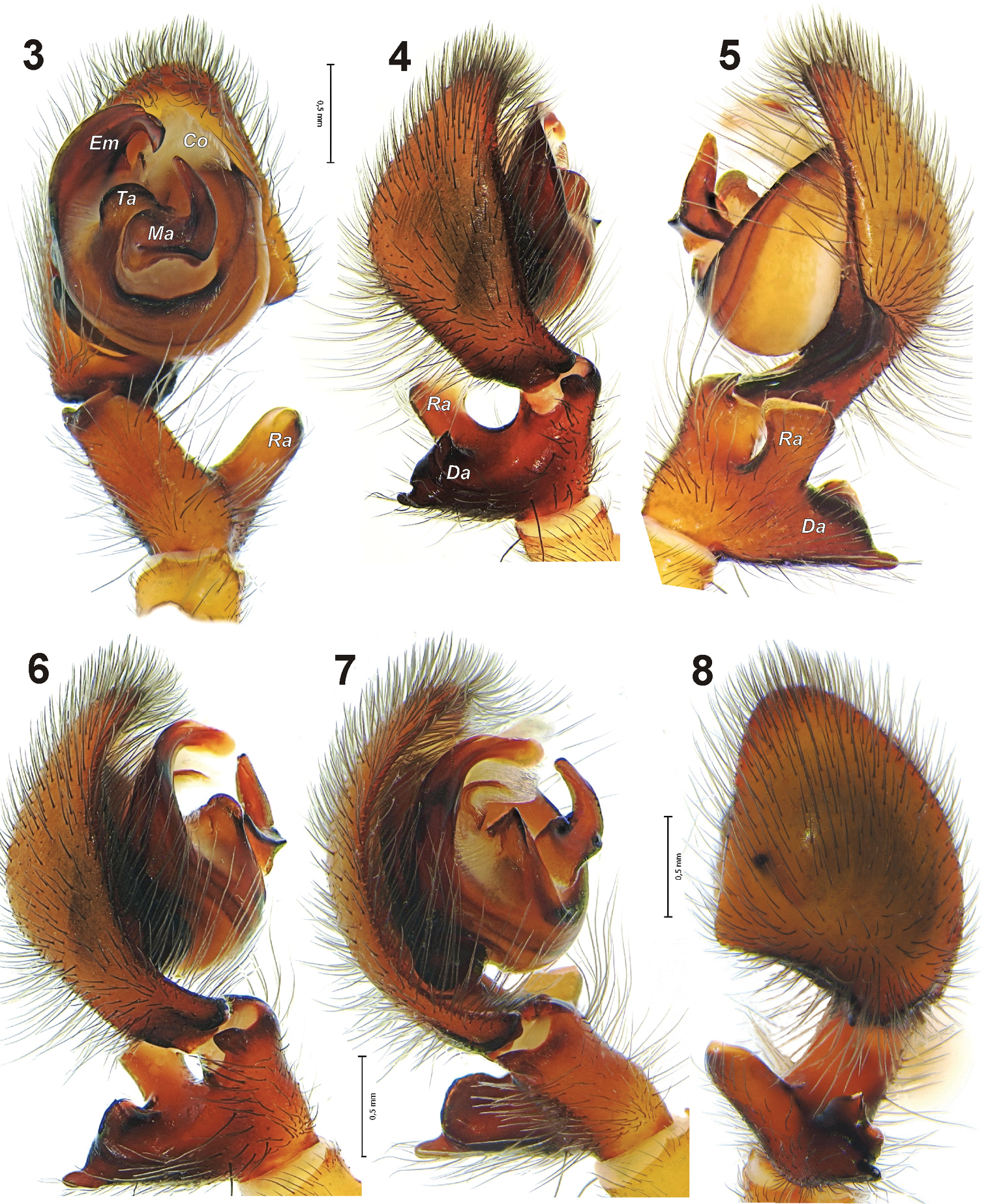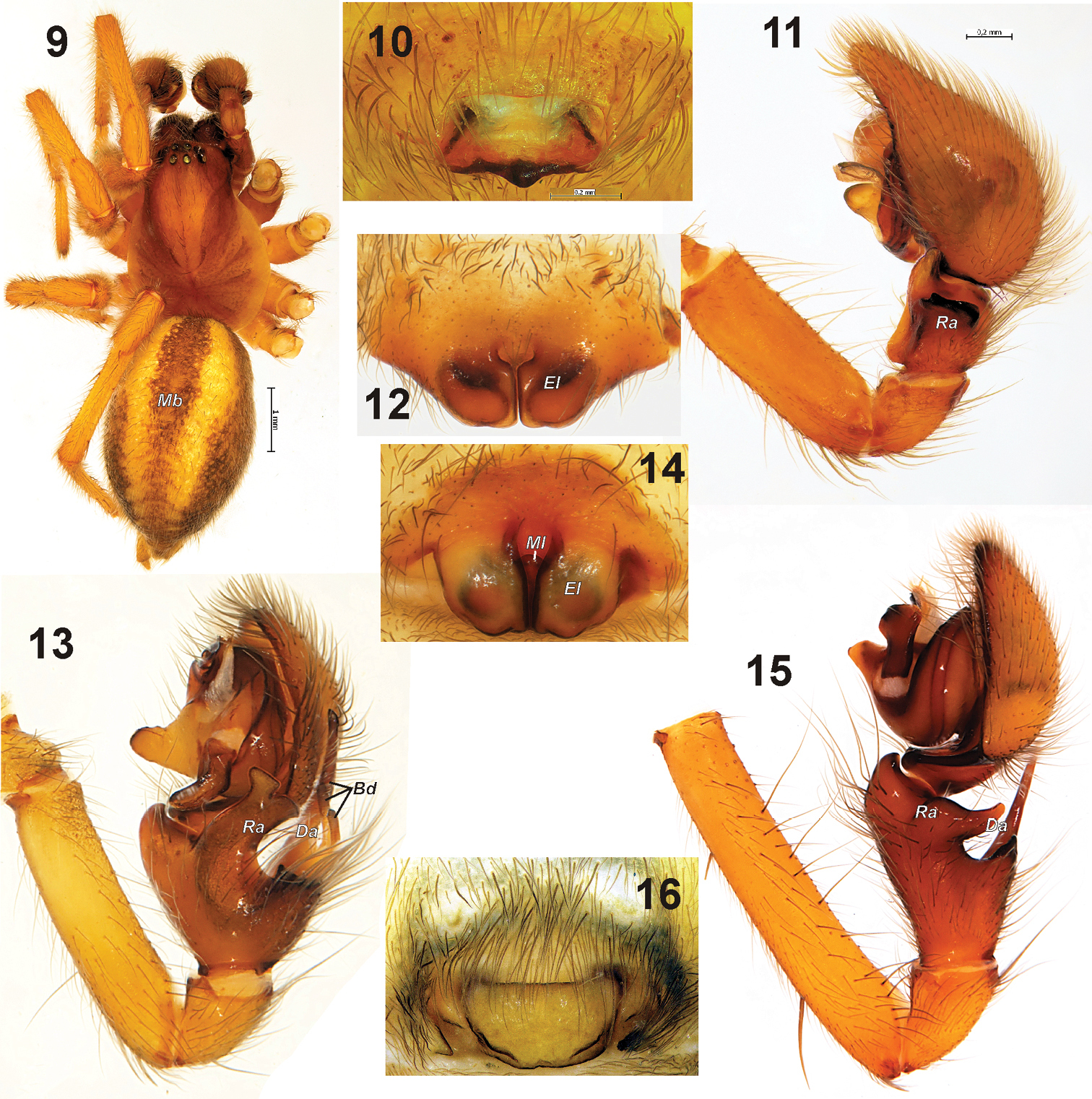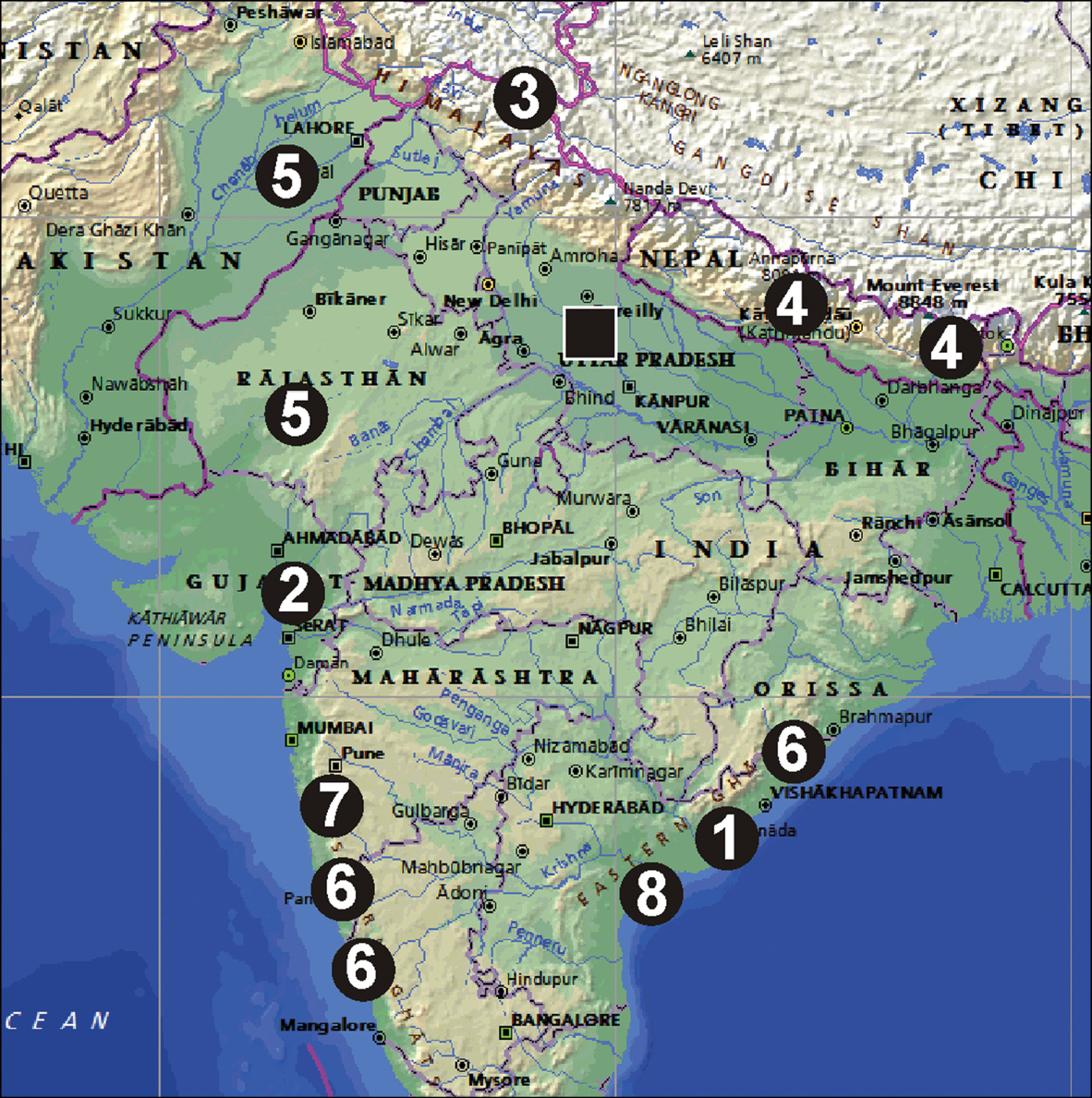






(C) 2011 Yuri M. Marusik. This is an open access article distributed under the terms of the Creative Commons Attribution License 3.0 (CC-BY), which permits unrestricted use, distribution, and reproduction in any medium, provided the original author and source are credited.
For reference, use of the paginated PDF or printed version of this article is recommended.
A new species, Amaurobius koponeni sp. n., is described from Himachal Pradesh on the basis of a male specimen. A key to all five genera of Amaurobiidae that occur in Asia is provided. Four species from India and Nepal incorrectly assigned to Amaurobius are transferred to three genera of Titanoecidae: Anuvinda milloti (Hubert, 1973), comb. n., Pandava andhraca (Patel & Reddy, 1990), comb. n., Pandava nathabhaii (Patel & Patel, 1975), comb. n., and Titanoeca sharmai (Bastawade, 2008), comb. n.
Amaurobiidae, Titanoecidae, India, Asia, key, new combination
Amaurobius C.L. Koch, 1837, is a rather large genus with 68 valid species names (
Recently, we found a specimen belonging to Amaurobius from northern India and whilst trying to identified it, we checked all species (descriptions) known from India and Nepal. The study of these descriptions revealed that all the so-called amaurobiid species were misplaced and actually belong to Titanoecidae, and at least Amaurobius sharmai is likely to belong to Titanoeca Thorell, 1870. Another Amaurobius, Amaurobius milloti Hubert, 1973, known from Nepal also seems to have been misplaced and belongs to the titanoecid genus Anuvinda Lehtinen, 1967.
The aims of this paper are to describe a new species of Amaurobius, to provide a key to the amaurobiid genera that occur in Asia, and to transfer the misplaced species to Titanoecidae.
Material and methodsMicrophotographs were made with an Olympus Camedia E-520 camera attached to an Olympus SZX16 stereomicroscope at the Zoological Museum, University of Turku. Digital images were montaged using “CombineZP” image stacking software. Photographs were taken in paraffin-based dishes using different sized holes to keep the samples in the required position. The holotype of the new species is preserved in the collections of the Museo Civico di Storia Naturale di Verona, Italy (MSNV). Comparative specimens illustrated are from Russia, Kunashir Island (Cybaeopsis and Callobius) and Magadan Area (Arctobius) and from Finland (female of Amaurobius fenestralis).
All measurements are in millimetres.
Taxonomic surveyTo date, five genera of amaurobiid spiders have been recorded from Asia east of the Caucasus: Amaurobius C.L. Koch, 1837 (India), Arctobius Lehtinen, 1967 (the whole of Siberia south to Mongolia), Callobius Chamberlin, 1947 (Far East), Cybaeopsis Strand, 1907 (Far East) and Taira Lehtinen, 1967 (Far East and South East). All genera except Arctobius (subfamily Arctobiinae) belong to the nominative subfamily Amaurobiinae. Arctobius differs distinctly from all other amaurobiids by colour, markings and eye arrangement. Amaurobiinae genera can be relatively easily distinguished by the structure of the palp in males and the epigyne in females. Taira has a reduced or absent retrolateral tibial apophysis (cf.
Females of Amaurobius and Taira have no distinct morphological differences (cf.
| 1 | Anterior median eyes equidistant from each other and anterior lateral eyes; abdomen with dark median band (Mb, Fig. 9), male palpal tibia without dorsal apophysis (Fig. 11), epigyne with strongly sclerotized median part of median plate (Fig. 10). Occurs in the whole of Siberia south to Mongolia | Arctobius agelenoides (Emerton, 1919) |
| – | Anterior median eyes closer to each other than to lateral eyes; median band not developed or developed only in anterior half (Fig. 1), male palpal tibia with distinct dorsal apophysis (Figs 2, 4–8, 13, 15), epigyne bilobate (Figs 12, 14) or with weakly sclerotized median plate (Fig. 16) | 2 |
| 2 | Dorsal tibial apophysis long, partly overlying cymbium (Figs 13, 15), epigyne bilobate (Figs 12, 14) | 3 |
| – | Dorsal tibial apophysis massive (Figs 2, 4–8), but not long, not overlying cymbium, epigyne with median plate, not bilobate (Fig. 16) | 4 |
| 3 | Dorsal tibial apophysis with three branches (Bd), retrolateral tibial apophysis (Ra) bilobate on the top (Fig. 13), epigyne without median lobe (Fig. 12). Occurs in Far East Asia. | Cybaeopsis typicus Strand, 1907 |
| – | Dorsal tibial apophysis not subdivided (Fig. 15), retrolateral tibial apophysis (Ra) elongate dorsally; epigyne with median lobe (Fig. 14). Occurs in Far East Asia | Callobius |
| 4 | Retrolateral tibial apophysis large (Figs 2–5, 8); tegular apophysis located near the base of median apophysis. Epigyne with transverse lobe or fovea (Fig. 16). Occurs in northern India. | Amaurobius |
| – | Retrolateral tibial apophysis small (knob-like) or absent; tegular apophysis originates near base of embolus. Occurs in Japan and China | Taira |
Comments. Cybaeopsis Strand, 1907 is a relatively small genus with 11 species, of which only one, Cybaeopsis typica Strand, 1907, occurs in Japan and the Russian Far East (Sakhalin, South and Middle Kuril Islands (
urn:lsid:zoobank.org:author:36297992-069D-47FC-9B60-9B26EB2C7698
http://species-id.net/wiki/Amaurobius_koponeni
Figs 1–8Holotype ♂ (MSNV), India, Uttar Pradesh, Farrukhabad District, Kaimganj City [=27.550°N, 79.332°E], 23.03.2003 (F. Abrescia).
The species is named after our friend and colleague Seppo Koponen (Turku, Finland).
The new species differs distinctly from other congeners by the shape of the tibial apophysis and the median apophysis.
Total length 9.8. Carapace length 4.95, width 3.4. Habitus as in Fig. 1. Carapace light brown with dorsal darker radiating strips, fovea and eye region dark brown. Chelicerae dark, swollen in front with four posterior and five anterior teeth.
Legs light brownish without rings, tarsi with three claws, scopula and claws tufts absent. Calamistrum about 1/3 of metatarsus length.
Length of leg segments:
Leg spination:
Sternum without pattern, same colour as carapace. Abdomen dark grey with dorsal and ventral pattern, cribellum clearly visible.
Palp as in Figs 2–8, tibia with large square-shaped retrolateral tibial apophysis (Ra) originating near the base of the tibia and almost as long as the tibia In ventral view the tibia and Ra have a V-shape; dorsal tibial apophysis (Da) large and massive, its length almost twice as long as the diameter of the tibia; intermediate apophysis not developed (or fused with Da). Retrobasal part of cymbium with long fold of about ½ of the cymbium. Median apophysis (Ma) massive, located in the center of the tegulum, basal half of it horizontal and terminal part almost vertical; conductor wide, as wide as basal half of Ma; embolus (Em) sharply pointed.
Male of Amaurobius koponeni sp. n. 1 habitus 2 left palp, retrolateral.
Left palp of Amaurobius koponeni sp. n. 3 ventral 4, 6–7 prolateral, different aspects showing the shape of the complex dorsal tibial apophysis 5 prolateral 8 dorsal. Abbreviations: Da dorsal tibial apophysis, Em embolus, Ma median apophysis, Ra retrolateral tibial apophysis, Ta tegular apophysis.
The new species is known from the type locality only, the area near the city of Kaimganj in Uttar Pradesh, India.
As mentioned above, three species of Amaurobius (Amaurobius andhracus Patel & Reddy, 1990, Amaurobius nathabhaii Patel & Patel, 1975 and Amaurobius sharmai Bastawade, 2008) have been recorded from India (
The genus Pandava was revised by
Habitus and copulatory organs of Arctobius agelenoides (9–11, from Magadan Area), Cybaeopsis typicus (12–13, from Kunashir Island), Callobius hokkaido (14–15, from Kunashir Island) and Amaurobius fenestralis (16, from South Finland). 9 habitus 10, 12, 14, 16 epigyne, ventral 11, 13, 15 left palp retrolateral. Abbreviations: Bdbranches of dorsal tibial apophysis, Da dorsal tibial apophysis, El lateral lobe of epigyne, Mlmedian lobe of epigyne Ra retrolateral tibial apophysis.
http://species-id.net/wiki/Anuvinda_milloti
This species is perfectly described from central and eastern Nepal (Fig. 17). Judging from the structure of the male palp, and particularly the modified patella, it undoubtedly belongs to Anuvinda Lehntinen, 1967, the type species of which, Anuvinda escheri (Reimoser, 1934) was recently well redescribed on the basis of both sexes by
Distribution of Amaurobius koponeni sp. n. (square), four species transferred here into Titanoecidae: Pandava andhraca 1 Pandava nathabhaii 2 Titanoeca sharmai 3 Anuvinda milloti 4 and four Pandava species recently described from India: Pandava shiva 5 Pandava ganga 6 Pandava kama 7 and Pandava ganesha 8.
http://species-id.net/wiki/Pandava_andhraca
This species was described on the basis of both sexes from Andhra Pradesh (Fig. 17), but the description and figures are of poor quality. Judging from the figures of the male palp this species belongs in Titanoecidae. Judging from the colour, shape of the epigyne and its distribution, the species belongs to Pandava, a titanoecid genus restricted to India, Sri Lanka, southern China, Myanmar and Thailand. The type species of the genus has a broader distribution. Judging from the shape of the epigyne, this species may be a junior synonym of Pandava laminata (Thorell, 1878), the type species of the genus, known from East Africa to the Philippines and Marquesas Islands.
http://species-id.net/wiki/Pandava_nathabhaii
This species was described on the basis of the female sex from Gujarat (Fig. 17), but the description and figures are of very poor quality. This species is placed in Titanoecidae because the other Indian species placed in Amaurobius belong to Titanoecidae. It is transferred to Pandava because of its southern distribution.
http://species-id.net/wiki/Titanoeca_sharmai
This species was described from the northeastern region of Himachal Pradesh, India (Fig. 17) on the basis of both sexes, but the figures and description are of rather poorly quality. The figures provided by the author, namely the tibial and metatarsal spines on the legs in males and the structure of the palp, leaves no doubt that the species belongs in Titanoecidae. Although there are three titanoecid genera in India, judging from the locality, high elevation, and the unmodified male palpal patella, Amaurobius sharmai must be placed in Titanoeca. It is worth mentioning that this species may be a junior synonym of Titanoeca intermedia Caporiacco, 1934 (species incorrectly synonymized with Titanoeca flavicoma L. Koch, 1872), which was described from territories now belonging to northeastern Pakistan and from northern India (Jammu & Kashmir).
We thank Seppo Koponen who gave us the opportunity to use the equipment available in the Zoology Museum, University of Turku and Leonardo Latella who allowed us to study the new Amaurobius species belonging to the collection of the Museo Civico di Storia Naturale di Verona, Italy. The English of an early draft was kindly checked by David Penney (Manchester). This work was supported in part by the Russian Foundation for Basic Research (grant № 11–0401716) and by the Finnish CIMO fellowship.



